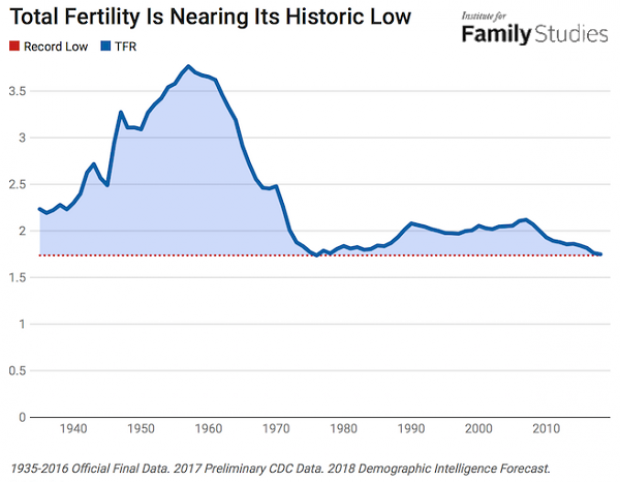Births in the U.S. fell to a multi-decade low last year, according to data from the National Center for Health Statistics released Tuesday. The provisional estimate shows 3.85 million births in the U.S. in 2017, the lowest tally since 1987, and an overall fertility rate of 1.76 births per woman, the lowest since 1978.
Births in the U.S. fell to a 30-year low last year, according to data released Tuesday by the National Center for Health Statistics. The provisional estimate shows 3.85 million births in 2017, the lowest tally since 1987. The total fertility rate fell to 1.76 births per woman, the lowest since 1978.
While pundits continue to debate the causes of the long-term drop in fertility – which include economic worries among millennials, lifestyle preferences for increasingly well-educated young women, and a downward trend in Hispanic family size – the implications for social safety net programs that rely on younger workers funding benefits for older citizens are significant.
Elizabeth Bauer of Forbes notes that most recent actuarial report from the trustees of Social Security assumes that the recent drop in fertility has been driven by the lingering effects of the recession of 2008 and therefore temporary. The trustees assume that the rate will rise as the economy strengthens, reaching 2.05 by 2023, then dropping slightly to 2.0 by 2027. But the latest data suggests that an improving economy may not produce the expected increase in fertility from current levels, leaving the U.S. below the replacement rate of 2.0 on a long-term and perhaps permanent basis.
Beyond the baseline scenario, the Social Security trustees consider other paths for population growth, including a “high-cost” scenario in which the fertility rate is 1.80. In that scenario, the smaller number of workers paying into the system over many decades means that the gap between revenues and outlays grows even larger than currently projected. By 2091 (the actuary report has a 75-year time horizon), outlays exceed income by 5.97 percent – significantly higher than the 4.48 percent shortfall estimated in the baseline scenario.
While there’s little doubt that fewer births could put a strain on the American social safety net, it’s worth noting that there are solutions to the problems produced by dropping fertility, including higher payroll taxes and increased immigration. But the latest demographic data can serve as a warning that those political solutions will need to be debated and implemented at some point.





